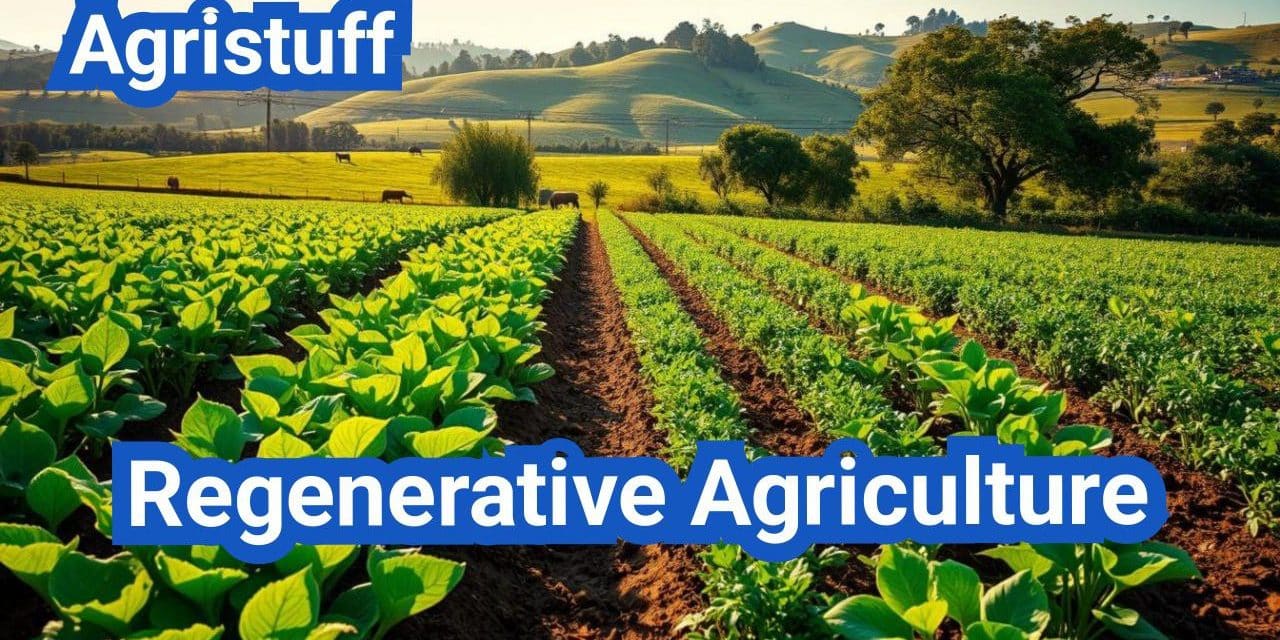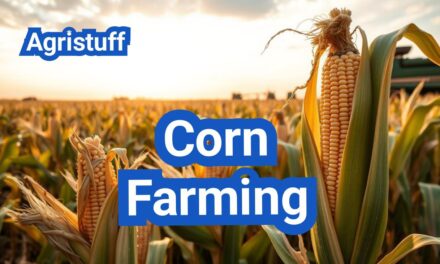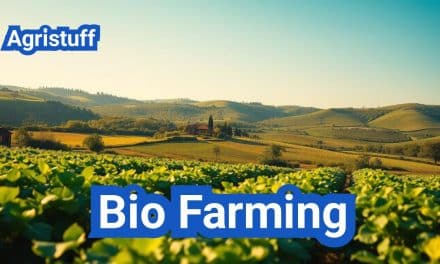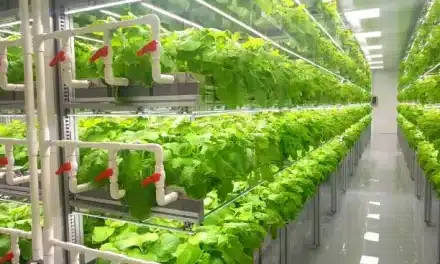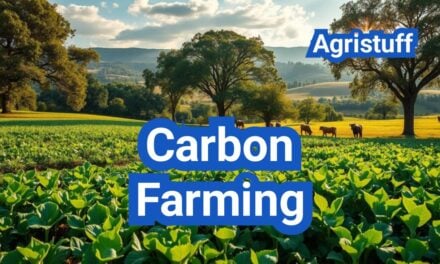Regenerative agriculture is a holistic approach to farming that focuses on soil regeneration, improving biodiversity, and enhancing ecosystem services. This method prioritizes sustainable farming practices that work with natural processes to promote a healthier environment.
By adopting regenerative agriculture, farmers can improve soil health, increase crop resilience, and contribute to a more sustainable food system. This approach is gaining attention for its potential to mitigate climate change by enhancing carbon sequestration and reducing synthetic inputs.
Key Takeaways
- Regenerative agriculture focuses on soil regeneration and biodiversity.
- It promotes sustainable farming practices and ecosystem services.
- This approach can enhance soil health and crop resilience.
- Regenerative agriculture contributes to a more sustainable food system.
- It has the potential to mitigate climate change.
What Is Regenerative Agriculture?
At its core, regenerative agriculture is an outcome-based food production system designed to enhance ecological health and farm productivity. This approach to farming focuses on nurturing and restoring soil health, protecting climate and water resources, and enhancing biodiversity.
Definition and Core Philosophy
Regenerative agriculture is defined by its holistic approach, aiming to regenerate the health of the entire ecosystem. It involves practices that improve soil structure, increase biodiversity, and enhance ecosystem services. The core philosophy revolves around the idea that by regenerating the land, we can create a more sustainable food system.
The definition of regenerative agriculture encompasses a range of practices, including minimizing soil disturbance, maintaining living root systems, and integrating livestock. These practices not only enhance soil carbon sequestration but also contribute to improved water cycles and biodiversity.
| Core Principles | Description |
|---|---|
| Minimizing Soil Disturbance | Reducing tillage to preserve soil health and structure |
| Maintaining Living Root Systems | Keeping roots in the soil to enhance soil biota and structure |
| Increasing Biodiversity | Promoting diverse ecosystems through varied crops and livestock |
Historical Development of Regenerative Farming
Regenerative agriculture has its roots in traditional farming practices that date back centuries. However, the modern concept began to take shape in the late 20th century as a response to the environmental degradation caused by industrial agriculture.
The historical development of regenerative farming is closely linked to the work of pioneers like Aldo Leopold, who advocated for a more holistic approach to land management. Over time, regenerative agriculture has evolved to incorporate a wide range of practices and techniques aimed at regenerating the health of the ecosystem.
As regenerative agriculture continues to gain momentum, it is clear that this approach has the potential to transform the way we produce food and manage natural resources. By understanding its definition, core philosophy, and historical development, we can better appreciate the significance of regenerative agriculture in creating a more sustainable future.
The Urgent Need for Regenerative Agriculture

As the world grapples with climate change and soil degradation, regenerative agriculture offers a promising pathway to sustainability. The current state of agriculture is alarming, with conventional farming practices leading to widespread environmental degradation.
Environmental Challenges in Conventional Farming
Conventional agricultural practices have resulted in significant environmental challenges, including soil erosion, biodiversity loss, and increased greenhouse gas emissions. Soil degradation is a critical issue, as it not only affects crop yields but also contributes to climate change by releasing stored carbon into the atmosphere.
The loss of biodiversity is another consequence of conventional farming, as monoculture practices and the use of chemical pesticides and fertilizers harm ecosystems. This not only affects wildlife but also reduces the resilience of farming systems, making them more vulnerable to pests, diseases, and climate variability.
Economic Benefits for Farmers and Communities
Regenerative agriculture offers numerous economic benefits for farmers and communities. By improving soil health and biodiversity, farmers can increase crop yields and reduce their reliance on external inputs, such as synthetic fertilizers and pesticides. This can lead to cost savings and improved profitability.
Moreover, regenerative agriculture can contribute to the development of more resilient and diverse local food systems, providing economic opportunities for rural communities. By promoting sustainable farming practices, regenerative agriculture can help ensure a more equitable and sustainable food system for future generations.
Core Principles of Regenerative Agriculture
At its core, regenerative agriculture is about adopting practices that regenerate the soil, improve biodiversity, and promote ecological balance. This approach to farming is guided by several key principles that work together to create more resilient and productive agricultural systems.
Minimizing Soil Disturbance
One of the foundational principles of regenerative agriculture is minimizing soil disturbance. This involves reducing or eliminating tillage, which can damage soil structure, disrupt soil biota, and lead to erosion. By minimizing soil disturbance, farmers can help preserve soil organic matter, improve soil health, and reduce the risk of soil erosion.
Maintaining Living Root Systems
Maintaining living root systems is another critical principle of regenerative agriculture. This involves keeping roots in the soil for as much of the year as possible through the use of cover crops, perennial plants, and crop rotations. Living roots help to stabilize the soil, feed soil biota, and improve soil structure.
Increasing Biodiversity
Increasing biodiversity is a key principle of regenerative agriculture. This can be achieved through practices such as crop rotation, intercropping, and integrating livestock into farming systems. By promoting biodiversity, farmers can create more resilient ecosystems that are better able to withstand pests, diseases, and climate change.
Integrating Livestock
Integrating livestock into farming systems is a crucial aspect of regenerative agriculture. Livestock can play a key role in maintaining ecosystem health by controlling weeds, improving soil fertility through manure, and promoting biodiversity. When managed correctly, livestock can be a valuable tool in regenerative farming systems.
| Principle | Benefits | Practices |
|---|---|---|
| Minimizing Soil Disturbance | Preserves soil organic matter, improves soil health, reduces erosion | No-till or reduced tillage, cover cropping |
| Maintaining Living Root Systems | Stabilizes soil, feeds soil biota, improves soil structure | Cover cropping, perennial plants, crop rotation |
| Increasing Biodiversity | Promotes ecosystem resilience, improves pest and disease management | Crop rotation, intercropping, integrating livestock |
| Integrating Livestock | Controls weeds, improves soil fertility, promotes biodiversity | Rotational grazing, multi-species grazing |
Soil Health Management in Regenerative Systems

Soil health management is a cornerstone of regenerative agriculture, focusing on practices that enhance soil biology, structure, and overall fertility. Effective soil health management is crucial for improving crop yields, sequestering carbon, and promoting biodiversity.
Understanding Soil Biology
Soil biology plays a vital role in soil health, with microorganisms such as bacteria and fungi contributing to nutrient cycling, soil structure, and plant health. Understanding soil biology is essential for developing strategies to promote soil health.
“The soil is a complex ecosystem that is home to a vast array of microorganisms, which are essential for maintaining soil health and fertility.”
Dr. Elaine Ingham, Soil Microbiologist
To promote soil biology, farmers can adopt practices such as:
- Reducing tillage to minimize soil disturbance
- Using cover crops to provide habitat for beneficial microorganisms
- Applying organic amendments to promote soil biota
Building Organic Matter
Building organic matter is critical for improving soil health, as it enhances soil structure, increases water-holding capacity, and provides nutrients for crops. Strategies for building organic matter include:
- Incorporating cover crops into rotations
- Using organic amendments such as compost or manure
- Reducing tillage to minimize soil disturbance
| Practice | Benefits |
|---|---|
| Cover Cropping | Enhances soil structure, increases biodiversity |
| Organic Amendments | Provides nutrients, promotes soil biota |
| Reduced Tillage | Minimizes soil disturbance, promotes soil organic matter |
Measuring and Monitoring Soil Health
Measuring and monitoring soil health is essential for evaluating the effectiveness of soil health management practices. Key indicators of soil health include:
- Soil organic matter content
- Soil structure and aggregation
- Microbial activity and diversity
By understanding and promoting soil biology, building organic matter, and measuring soil health, farmers can improve the overall health and resilience of their soils, contributing to a more sustainable agricultural system.
Essential Regenerative Farming Techniques
Essential techniques in regenerative farming are transforming agricultural landscapes. These methods focus on improving soil health, increasing biodiversity, and enhancing ecosystem services. By adopting these practices, farmers can improve the sustainability of their operations and contribute to a healthier environment.
No-Till and Reduced Tillage Methods
No-till and reduced tillage methods are crucial in regenerative farming. These techniques minimize soil disturbance, preserving soil organic matter and reducing erosion. By reducing tillage, farmers can improve soil structure, enhance water retention, and promote soil biota. This approach also helps in reducing fuel consumption and lowering emissions.
Cover Cropping Strategies
Cover cropping is another vital technique in regenerative agriculture. It involves planting crops between crop cycles to protect and enhance the soil. Cover crops help in reducing soil erosion, improving soil health, and increasing biodiversity. They can also provide habitat for beneficial insects and pollinators, further enhancing ecosystem services.
Crop Rotation and Diversification
Crop rotation and diversification are fundamental to regenerative farming. Rotating crops helps in breaking disease and pest cycles, improving soil fertility, and increasing crop yields. Diversification of crops also enhances ecosystem services and promotes biodiversity, making farming systems more resilient to climate change.
Organic Soil Management
Organic soil management is a cornerstone of regenerative agriculture. This involves using natural amendments and practices to enhance soil health. Techniques include adding compost, using cover crops, and minimizing synthetic fertilizers. Organic soil management improves soil structure, increases water retention, and promotes soil biota, leading to more sustainable and productive farming systems.
By implementing these essential regenerative farming techniques, farmers can significantly improve the sustainability of their operations. These practices not only enhance soil health and biodiversity but also contribute to a more resilient agricultural system capable of withstanding the challenges of climate change.
Implementing Regenerative Grazing Systems

By adopting regenerative grazing practices, farmers can enhance soil health, biodiversity, and overall farm resilience. This approach to grazing management not only improves the environmental footprint of farming operations but also contributes to more sustainable and productive agricultural systems.
Rotational and Adaptive Grazing
Rotational grazing involves moving livestock to different areas of the pasture to allow the vegetation in the previous area to recover. This method helps in maintaining the health of the pasture, reducing erosion, and increasing biodiversity. Adaptive grazing takes this a step further by adjusting the grazing schedule based on the condition of the pasture and the needs of the livestock.
“The key to successful rotational grazing is to monitor the pasture’s condition closely and adjust the grazing schedule accordingly.”
Implementing rotational and adaptive grazing requires careful planning and monitoring. Farmers need to assess the carrying capacity of their pastures, the nutritional needs of their livestock, and the impact of grazing on soil health.
Multi-Species Grazing Benefits
Multi-species grazing involves grazing different species of livestock together on the same pasture. This approach can lead to more efficient use of forage, as different species graze on different types of vegetation. It also promotes biodiversity by creating a more diverse habitat.
- Increased biodiversity
- Improved forage utilization
- Enhanced ecosystem services
The benefits of multi-species grazing are multifaceted, contributing to the overall health and resilience of the grazing system. By incorporating different grazing animals, farmers can create a more balanced and sustainable ecosystem.
Agroforestry and Perennial Systems

Agroforestry practices, including silvopasture and alley cropping, are being adopted worldwide to create more diverse and resilient farming systems. These systems integrate trees into agricultural landscapes, enhancing ecological interactions and promoting biodiversity.
Silvopasture Design and Management
Silvopasture systems combine trees, forage, and livestock in a single management unit, optimizing the physical and biological interactions between these components. Proper design and management of silvopasture systems can lead to increased biodiversity, improved soil health, and enhanced livestock productivity.
The key to successful silvopasture design lies in selecting the right tree species, managing tree density, and implementing appropriate grazing strategies. For example, integrating trees like oak or pine into pastures can provide shade for livestock, improve soil fertility through leaf litter, and create habitat for wildlife.
Food Forests and Alley Cropping
Food forests, also known as permaculture systems, mimic natural ecosystems by creating diverse, multi-layered agricultural landscapes. These systems can include a variety of crops, from fruit trees and nut trees to vegetables and herbs, all designed to work together synergistically.
Alley cropping is another agroforestry practice that involves planting crops between rows of trees. This technique can improve soil health, reduce erosion, and increase biodiversity. For instance, planting soybeans or corn between rows of walnut trees can provide additional income while the trees mature.
Both food forests and alley cropping systems require careful planning and management to ensure their success. This includes selecting appropriate crop and tree combinations, managing competition for resources, and maintaining soil fertility.
Water Management in Regenerative Agriculture

Regenerative farming practices prioritize water management to foster a more resilient agricultural ecosystem. Effective water management is essential for maintaining soil health, supporting biodiversity, and ensuring crop productivity.
Rainwater Harvesting Techniques
Rainwater harvesting is a critical component of water management in regenerative agriculture. It involves collecting and storing rainwater for use during dry periods, reducing reliance on groundwater and mitigating the impact of droughts.
- Implementing rainwater harvesting systems can help reduce water waste and improve water efficiency.
- Techniques such as constructing ponds, reservoirs, and rooftop collection systems can be employed.
- Rainwater harvesting not only conserves water but also helps in recharging groundwater.
Drought Resilience Strategies
Drought resilience is crucial for farms practicing regenerative agriculture, as it enables them to withstand and recover from drought conditions.
| Strategy | Description | Benefits |
|---|---|---|
| Cover Cropping | Planting cover crops to protect and enhance soil health. | Reduces soil erosion, improves soil water-holding capacity. |
| Mulching | Applying organic mulch to soil surface. | Conserves soil moisture, suppresses weeds. |
| Crop Diversification | Growing a variety of crops to spread risk. | Enhances farm resilience, improves biodiversity. |
By implementing these drought resilience strategies, farmers can improve their ability to cope with water scarcity, ensuring the long-term sustainability of their regenerative agriculture practices.
Transitioning to Regenerative Agriculture

Transitioning to regenerative agriculture requires a thoughtful and multi-step approach. It’s a journey that involves changing farming practices, mindset, and often, the economic models associated with agriculture.
Regenerative agriculture offers a promising path towards sustainable farming, enhancing biodiversity, improving soil health, and contributing to climate change mitigation. The transition process, while challenging, can be rewarding and profitable in the long term.
Assessment and Planning
The first step in transitioning to regenerative agriculture is a thorough assessment of the current farming system. This involves evaluating soil health, biodiversity, water resources, and existing farming practices. A comprehensive assessment helps in identifying areas that need improvement and opportunities for regenerative practices.
Planning is crucial and should be based on the assessment. It involves setting clear goals, such as improving soil organic matter, increasing biodiversity, or reducing chemical inputs. Farmers should also consider their resources, including labor, equipment, and financial capabilities.
| Assessment Criteria | Current Status | Regenerative Goal |
|---|---|---|
| Soil Organic Matter | 2% | 5% |
| Biodiversity | Low | High |
| Chemical Inputs | High | Low |
Implementing Changes Gradually
Implementing regenerative practices should be done gradually. Starting with small, manageable changes can help farmers adapt to new techniques without overwhelming their resources. For instance, beginning with cover cropping on a small portion of the land can provide valuable experience before scaling up.
Farmers can adopt various regenerative practices, such as no-till or reduced-till farming, integrating livestock into their systems, or implementing agroforestry. Each change should be carefully planned and monitored.
“The key to successful regenerative agriculture is not just adopting new practices, but understanding the ecosystem you’re working with and enhancing its natural processes.” – Gabe Brown, Regenerative Farmer
Measuring Progress and Adapting
Measuring progress is essential to understand the effectiveness of the regenerative practices implemented. This can involve monitoring soil health indicators, tracking biodiversity changes, or assessing the economic impacts of the new practices.
Adapting strategies based on the outcomes is crucial. Not all practices will work equally well on every farm, and continuous learning and adaptation are key to successful regenerative agriculture.
Transitioning to regenerative agriculture is a journey that requires patience, planning, and persistence. By assessing their current systems, implementing changes gradually, and measuring progress, farmers can successfully adopt regenerative practices that benefit both their operations and the environment.
Carbon Sequestration Through Regenerative Practices

Carbon sequestration is a critical benefit of regenerative agriculture, offering a pathway to reduce atmospheric CO2 levels. Regenerative farming practices focus on enhancing soil health, improving biodiversity, and promoting ecosystem services, all of which contribute to its carbon sequestration potential.
How Regenerative Farming Captures Carbon
Regenerative farming captures carbon primarily through soil conservation and enhancement techniques. Practices such as no-till or reduced-till farming, cover cropping, and incorporating organic amendments help build soil organic matter, which acts as a significant carbon sink.
Key methods include:
- Minimizing soil disturbance to preserve soil carbon
- Increasing soil cover with cover crops and residues
- Incorporating diverse crop rotations and intercropping
- Integrating livestock grazing to enhance soil health
These practices not only sequester carbon in soils but also contribute to overall ecosystem health and resilience.
Quantifying Climate Benefits
Quantifying the climate benefits of regenerative agriculture is essential for understanding its impact and potential. This involves measuring changes in soil carbon stocks, tracking greenhouse gas emissions reductions, and assessing overall ecosystem health improvements.
A comprehensive approach to quantifying climate benefits includes:
| Indicator | Description | Measurement Method |
|---|---|---|
| Soil Carbon Stocks | Amount of carbon stored in soil | Soil sampling and analysis |
| Greenhouse Gas Emissions | Reduction in emissions due to regenerative practices | Emissions monitoring equipment |
| Ecosystem Health | Overall health and biodiversity of the ecosystem | Biodiversity surveys and assessments |
By adopting regenerative practices and quantifying their climate benefits, farmers and policymakers can better understand the potential of regenerative agriculture to mitigate climate change.
Successful Regenerative Agriculture Examples

Regenerative agriculture examples from around the world illustrate the practice’s versatility and its capacity to improve soil health, biodiversity, and farm productivity. These examples demonstrate that regenerative agriculture can be successfully implemented in various climates and regions, from tropical to temperate zones.
Case Studies from Diverse Climates
Several case studies highlight the effectiveness of regenerative agriculture in different environmental conditions. For instance, in the drylands of Africa, farmers have adopted regenerative practices such as conservation agriculture and agroforestry, resulting in improved soil moisture retention and increased crop yields.
In contrast, farmers in the humid regions of Southeast Asia have successfully implemented regenerative agriculture by integrating livestock grazing with crop production, enhancing biodiversity and reducing the need for external inputs.
Key outcomes from these case studies include:
- Increased soil organic matter and improved soil structure
- Enhanced biodiversity, including both flora and fauna
- Improved water retention and reduced erosion
- Increased crop yields and farm productivity
Lessons from Regenerative Farmers of America
Regenerative farmers across America are sharing their experiences and insights, providing valuable lessons for others looking to adopt regenerative practices. One key lesson is the importance of soil health monitoring and management, which involves regular testing and adjusting farming practices accordingly.
Another crucial lesson is the need for flexibility and adaptability in regenerative farming systems. Farmers are learning to respond to changing weather patterns and market demands by diversifying their crops and integrating livestock into their operations.
“Regenerative agriculture is not just about farming; it’s about creating a holistic system that works with nature to produce healthy food while enhancing the environment.” – Gabe Brown, regenerative farmer
By studying these examples and lessons, farmers and agricultural practitioners can gain a deeper understanding of how to successfully implement regenerative agriculture in their own contexts, contributing to a more sustainable food system.
Overcoming Challenges in Regenerative Farming

While regenerative farming offers a promising path towards sustainable agriculture, several hurdles must be overcome. Regenerative agriculture, known for its potential to improve soil health, biodiversity, and ecosystem services, faces challenges that can hinder its adoption and success.
Economic Hurdles and Solutions
One of the significant challenges facing regenerative farming is economic. The initial transition costs, including changes in equipment, seeds, and labor, can be substantial. However, several solutions are being implemented to address these economic hurdles.
- Government incentives and subsidies for farmers transitioning to regenerative practices.
- Access to affordable financing options through specialized agricultural loans.
- Development of markets for regenerative products, allowing farmers to command a premium price.
These economic solutions not only help farmers overcome the initial financial barriers but also provide a sustainable financial model for regenerative farming.
Knowledge Gaps and Resources
Another challenge is the knowledge gap among farmers, agricultural professionals, and the broader community about regenerative farming practices. To address this, various resources are being developed.
| Resource Type | Description | Benefit |
|---|---|---|
| Workshops and Training Programs | Practical, hands-on training for farmers and agricultural professionals. | Equips participants with the skills needed to implement regenerative practices. |
| Online Courses and Webinars | Flexible, accessible educational content covering various aspects of regenerative farming. | Reaches a wider audience, including those in remote areas. |
| Regenerative Farming Networks | Community-driven platforms for sharing knowledge, experiences, and best practices. | Fosters collaboration and innovation among regenerative farming practitioners. |
By addressing both economic hurdles and knowledge gaps, the agricultural community can accelerate the adoption of regenerative farming practices, contributing to a more sustainable food system.
Finally: The Future of Regenerative Agriculture
Regenerative agriculture is revolutionizing the way we think about farming and food production, promoting sustainable and environmentally conscious practices. As the world grapples with climate change, soil degradation, and biodiversity loss, regenerative agriculture offers a promising solution.
The future of regenerative agriculture looks bright, with its potential to shape the future of farming and promote sustainable practices. By adopting regenerative practices, farmers can improve soil health, increase biodiversity, and reduce environmental impacts.
As regenerative agriculture continues to gain momentum, it is likely to play a critical role in shaping the future of sustainable farming. With its focus on soil health, biodiversity, and ecosystem services, regenerative agriculture has the potential to create a more resilient and sustainable food system.
FAQ
What is regenerative agriculture?
Regenerative agriculture is a holistic approach to farming that prioritizes soil health, biodiversity, and ecosystem services. It involves practices like minimizing soil disturbance, maintaining living root systems, and integrating livestock to promote ecological balance and improve farm productivity.
What are the core principles of regenerative agriculture?
The core principles of regenerative agriculture include minimizing soil disturbance, maintaining living root systems, increasing biodiversity, and integrating livestock. These principles work together to promote soil health, ecosystem services, and farm productivity.
How does regenerative agriculture improve soil health?
Regenerative agriculture improves soil health by promoting soil biology, building organic matter, and using cover crops and crop rotation. This approach enhances soil structure, increases water retention, and supports beneficial microbial activity.
What are some essential regenerative farming techniques?
Essential regenerative farming techniques include no-till and reduced tillage methods, cover cropping strategies, crop rotation and diversification, and organic soil management. These techniques help to promote soil health, reduce erosion, and increase biodiversity.
How does regenerative grazing work?
Regenerative grazing involves rotational and adaptive grazing practices that mimic natural grazing patterns. This approach promotes soil health, increases biodiversity, and enhances ecosystem services by allowing pastures to rest and recover between grazing periods.
What is agroforestry, and how is it used in regenerative agriculture?
Agroforestry involves integrating trees into farming systems to promote ecological interactions and synergies. In regenerative agriculture, agroforestry is used to create silvopasture systems, food forests, and alley cropping systems that enhance biodiversity, improve soil health, and increase ecosystem services.
How does regenerative agriculture help to mitigate climate change?
Regenerative agriculture helps to mitigate climate change by sequestering carbon in soils and biomass, reducing synthetic fertilizer use, and promoting ecosystem services. Practices like cover cropping, crop rotation, and agroforestry can help to capture and store carbon, reducing atmospheric CO2 levels.
What are the economic benefits of regenerative agriculture?
The economic benefits of regenerative agriculture include improved crop yields, reduced input costs, and increased farm resilience. Regenerative agriculture can also provide new revenue streams through carbon credits, ecosystem services, and premium prices for regeneratively produced products.
How can farmers transition to regenerative agriculture?
Farmers can transition to regenerative agriculture by assessing their current practices, setting clear goals, and implementing changes gradually. This may involve starting with small-scale trials, seeking technical assistance, and monitoring progress to adapt and improve their regenerative practices.
What are some common challenges faced by regenerative farmers?
Common challenges faced by regenerative farmers include economic hurdles, knowledge gaps, and limited access to resources and technical assistance. Regenerative farmers may also face challenges related to scaling up production, managing complex ecosystems, and navigating regulatory frameworks.
Conclusion of: Regenerative Agriculture
Regenerative agriculture is becoming a significant trend in sustainable farming, aiming not only at sustaining natural resources but also regenerating and enhancing them. This innovative agricultural practice has been gaining traction, especially in the United States, due to its profound environmental, social, and economic impacts.
What is Regenerative Agriculture?
Regenerative agriculture is a system of farming practices designed to rehabilitate and enhance the entire ecosystem of the farm by placing significant emphasis on soil health, water management, biodiversity, and carbon sequestration. Unlike conventional agriculture, regenerative agriculture seeks to actively restore and regenerate the environment, making it sustainable in the long term.
At its core, regenerative agriculture aims to rebuild soil organic matter and restore degraded soil biodiversity, which, in turn, leads to improved water cycles and carbon sequestration. The practice not only ensures agricultural productivity but also addresses climate change and environmental degradation.
Learn more about regenerative agriculture from the USDA.
Key Practices in Regenerative Agriculture
No-Till Farming
One of the essential practices in regenerative agriculture is no-till farming, which reduces soil erosion and helps maintain soil structure. By avoiding the turning of soil, no-till farming preserves microbial life and helps retain moisture.
Explore no-till farming from Penn State Extension.
Cover Cropping
Cover crops like clover, peas, and rye are planted to protect and enrich the soil. These plants prevent erosion, reduce weed growth, and improve soil fertility and structure through nitrogen fixation and organic matter addition.
Read more about cover cropping from the Sustainable Agriculture Research and Education Program.
Crop Rotation
Crop rotation is the practice of growing different crops sequentially on the same land. This practice interrupts pest cycles, improves soil nutrients, and enhances biodiversity, contributing significantly to regenerative agriculture.
Learn more about crop rotation from Iowa State University Extension.
Composting
Composting enriches the soil by adding nutrient-rich organic matter, supporting microorganisms beneficial for plant health and soil regeneration. Composting also aids in moisture retention and reduces reliance on chemical fertilizers.
Find detailed composting information from EPA.
Agroforestry
Integrating trees into agricultural systems—known as agroforestry—provides habitat for beneficial wildlife, enhances biodiversity, improves water retention, and helps sequester carbon dioxide, playing a vital role in regenerative agriculture.
Discover agroforestry from the USDA National Agroforestry Center.
Managed Grazing
Managed grazing practices involve systematically rotating livestock through pastures. This ensures that grasses and plants regenerate adequately, enhancing soil health and productivity while reducing erosion and improving pasture biodiversity.
Learn about managed grazing from the University of Minnesota Extension.
Benefits of Regenerative Agriculture
Environmental Benefits
Regenerative agriculture greatly benefits the environment by reducing soil erosion, enhancing water retention, increasing biodiversity, and actively sequestering atmospheric carbon dioxide.
Explore more environmental benefits from the Natural Resources Defense Council.
Economic Benefits
Farmers adopting regenerative agriculture practices often experience improved yields, reduced input costs, and higher profitability over the long term. Healthy soils reduce dependency on costly synthetic fertilizers and pesticides.
Check economic impacts via Sustainable Agriculture Research & Education.
Social Benefits
Communities practicing regenerative agriculture experience improved health due to reduced exposure to chemical fertilizers and pesticides, increased food security, and stronger community cohesion through local agricultural initiatives.
Social impacts outlined by Rodale Institute.
Examples of Regenerative Agriculture in Action
Gabe Brown’s Ranch (North Dakota)
Gabe Brown, a prominent advocate for regenerative agriculture, transformed his degraded farmland using no-till farming, diverse cover crops, crop rotations, and managed grazing. This resulted in significantly improved soil fertility and productivity.
Visit Gabe Brown’s success story at Understanding Ag.
Polyface Farm (Virginia)
Joel Salatin of Polyface Farm integrates regenerative practices such as pasture rotation, composting, and agroforestry. This sustainable management has turned Polyface Farm into a highly productive, environmentally sustainable agricultural model.
See Polyface Farm’s approach on their official website.
White Oak Pastures (Georgia)
White Oak Pastures practices holistic regenerative agriculture, employing managed grazing, composting, and biodiversity enhancement. This farm has successfully demonstrated economic viability alongside remarkable environmental benefits.
Singing Frogs Farm (California)
Singing Frogs Farm employs innovative no-till farming, intensive composting, and cover cropping methods. This approach significantly increased soil organic matter and farm productivity while reducing water usage and environmental impact.
Learn about Singing Frogs Farm.
How to Transition to Regenerative Agriculture?
Transitioning to regenerative agriculture involves learning, planning, and gradual implementation. Here are practical steps for farmers interested in making this shift:
- Educate Yourself: Learn about regenerative practices through courses, workshops, and online resources.
- Start Small: Begin with a portion of land, applying one or two regenerative practices.
- Monitor Progress: Document soil health, crop yields, and ecosystem improvements to track your success.
- Expand Gradually: Slowly integrate additional practices into your farming system.
Get guidance from Regenerative Organic Alliance.
Challenges and Considerations
While regenerative agriculture offers numerous benefits, transitioning can present several challenges:
- Initial Investment: Costs involved in adopting new equipment or practices.
- Knowledge Gap: Farmers must learn new methods, often requiring substantial initial education.
- Time Lag: Environmental benefits and financial returns may take time to manifest.
Understand potential challenges via ATTRA Sustainable Agriculture.
Final Thought
Regenerative agriculture represents a significant shift from traditional farming methods, fostering a healthier environment, sustainable economic gains, and stronger community ties. As climate concerns escalate, adopting regenerative agriculture becomes increasingly critical. Supporting and expanding regenerative farming practices not only contributes positively to the environment but also builds resilience into our agricultural and food systems.

